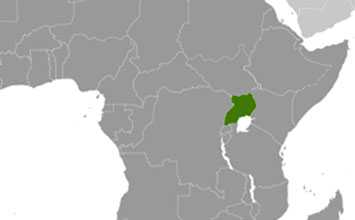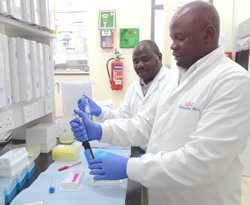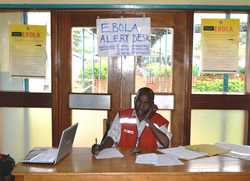
The Centers for Disease Control and Prevention (CDC) has supported the government of Uganda (GOU) for more than 25 years to advance science-based public health initiatives to help the country confront its unique health issues and to improve the health of its citizens. With a focus on the prevention, control, and treatment of HIV/AIDS, CDC delivers evidence-based quality health services, strengthens health systems, and enhances partnerships. CDC also supports TB and malaria programs, maternal and child health services, and vaccination programs. Additionally, CDC works to advance global health security by improving Uganda’s ability to prevent, detect, and respond to public health threats.

Travelers’ Health Uganda

Staff
CDC office (physical presence)
112 Locally Employed Staff
15 U.S. Assignees

Uganda at a Glance
Population: 36.6 million
Per capita income: $1,780
Life expectancy at birth women/men: 62/64 yrs
Under 5 mortality: 53/1000 live births
Source: CCHSource Population Reference Bureau 2016-Uganda

Top 10 Causes of Death
Source: GBD Compare 2015, Uganda
- Diarrheal Diseases
- Neonatal Disorders
- HIV/AIDS & TB
- Neglected Tropical Diseases and Malaria
- Other Noncommunicable Diseases
- Diabetes/Urological/Blood/Endocrine Diseases
- Cardiovascular Diseases
- Nutritional Deficiencies
- Unintentional Injuries
- Mental Illness & Substance Use
In the News
- Plague draws attention amid concern that it might be deployed by terrorists WP
- The Hunt for Ebola Smithsonian.com
- Ebola outbreak tests local surveillance: Ugandan laboratory helps to minimize number of cases. Nature News
- Ugandan officials, international experts tackle Ebola outbreak that’s killed 14 CNN
Impact in Uganda
- During 2016, provided ART to 516,200 people and conducted 4,555,301 HIV tests. Provided PMTCT services to 51,875 pregnant women.
- From 2010-2016, CDC supported 1,205,306 voluntary medical male circumcisions in Uganda.
- Uganda Public Health EOC has activated and coordinated over 20 outbreak responses including yellow fever, CCHF, rift valley fever, Marburg, H5N8, typhoid, cholera, and malaria.
- Supported 216 faith-based private, not-for-profit healthcare facilities in 62 districts across Uganda in procurement and supply of HIV medicines and related commodities. This has enabled 250,000 Ugandans to have access to uninterrupted drug treatment from 2011–2016.
- Supported construction of the Uganda National Health Laboratory Services. This has improved coordination of laboratory services through the effective national sample transport network and supported access to quality laboratory services.
- Uganda now has trained Frontline Disease Detectives in all of Uganda’s 118 districts who are working to contain outbreaks quickly wherever they occur.
- To complement past AIDS Indicator Survey data, CDC supported the Uganda MOH in conducting a Population-based HIV Impact Assessment survey to measure reach and impact of the country’s HIV services.
- Maintained polio-free status and strengthened the EPI system to prevent, detect, and respond appropriately to outbreaks of vaccine-preventable diseases.
- Established a national BSL-3 reference laboratory for viral hemorrhagic fevers (VHFs), which helped detect and confirm 12 individual VHF outbreaks in Uganda and one VHF outbreak from the Democratic Republic of Congo.
HIV/AIDS

CDC is committed to working with Uganda to stop the HIV epidemic and to mitigate the impact of AIDS. Driven by up-to-date data on disease burden and prevalence, CDC works with Uganda’s Ministry of Health (MOH) and other partners to support Uganda in achieving UNAIDS’ 90-90-90 goals by 2020. This means 90% of all Ugandans living with HIV know their HIV status, 90% of all Ugandans diagnosed with HIV infection receive sustained antiretroviral therapy (ART), and 90% of all Ugandans receiving ART receive viral load monitoring.
CDC also supports TB diagnosis through systemic screening of clients attending HIV clinics. With an emphasis on linkage to HIV care and ART for TB/HIV coinfected clients, CDC has integrated these services into existing programs along with preventive TB therapy. In 2016, CDC supported provision of ART to 7,366 out of 8,368 TB/HIV co-infected clients.
Malaria
CDC jointly manages the U.S. President’s Malaria Initiative (PMI) activities in Uganda by supporting the MOH and other partners in developing proven policies and programs that reduce the burden of malaria. CDC provides technical support in strengthening healthcare-facility-based malaria diagnostics, case management, preventing malaria in pregnancy, and malaria surveillance. CDC further supports the National Malaria Control Program in operational research, monitoring insecticide and antimalarial resistance, as well as strengthening vector-control strategies including indoor residual spraying and distribution and utilization of insecticide-treated mosquito nets.
Emerging Infections

CDC has also established surveillance and lab capacity for public health threats including plague, yellow fever, highly pathogenic zoonotic viruses such as Ebola virus, Rift Valley fever virus, and Crimean-Congo hemorrhagic fever (CCHF) virus. Today, there are over 20 sentinel surveillance sites in healthcare facilities throughout Uganda. This highly successful program has dramatically improved the capacity of Uganda to detect and quickly respond to these highly pathogenic viruses, reducing case counts, and saving lives. CDC also helps local public health authorities recognize and respond to outbreaks of acute febrile illness in an effort to improve testing and treatment protocols. The impact of this work in Uganda is highly sustainable as it has increased infectious disease surveillance and outbreak response capacities and has bolstered basic laboratory detection and diagnostic capabilities. The emerging infectious disease activities in Uganda have also strengthened regional collaboration with Uganda serving as a laboratory reference for other countries.
Global Health Security (GHS)
CDC supports the GOU in building critical response capabilities to create a world safe and secure from infectious disease threats and to elevate GHS as a national priority. With the country’s history of high-profile disease outbreaks (including, in recent years, Ebola and Marburg hemorrhagic fevers, yellow fever, typhoid, cholera, and hepatitis E), Uganda has been an early adopter and champion of the GHS agenda. In partnership with the MOH, the Uganda Virus Research Institute and other U.S. government agencies, CDC is supporting Uganda in meeting WHO’s International Health Regulations and in strengthening the country’s preparedness to respond to emerging and reemerging pandemic threats. CDC helps strengthen Uganda’s nationwide public health laboratory system by increasing the capacity and competence of diagnostic laboratories and specimen referral networks. It also works with Uganda to develop a public health emergency operations center (EOC) to manage complex public health responses. Evidence of CDC’s support for enhanced surveillance and laboratory capacity is seen in faster disease detection and response, including a 10-fold decrease–from 40 days in 2010 to 4 days in 2016–for in-country yellow fever detection during outbreaks. These efforts are further supported by a strong partnership with the MOH and the Makerere University School of Public Health in building workforce capacity through the Field Epidemiology Training Program.
Health Systems Strengthening

CDC works with the MOH to strengthen national and local public health workforces, which are critical elements in achieving targets for comprehensive and sustainable healthcare service delivery. The agency contributed to the accelerated recruitment of healthcare workers, which has significantly supported scaling up of HIV/AIDS services in government and nonprofit facilities. CDC further supports procurement and supply chain strengthening to improve access to HIV/AIDS medicines and related commodities across the country through private, not-for-profit facilities and supports their institutional capability to manage these commodities. Maternal and Child Health In addition to its work to support Uganda’s Prevention of Mother-to-Child Transmission (PMTCT) and pediatric HIV programs, CDC has played a major role in the U.S. government’s “Saving Mothers, Giving Life (SMGL)” pilot project in Uganda. SMGL focused on scaling up high-impact interventions to reduce Uganda’s maternal mortality rate, which is among the highest in the world. The project, which ended in early 2017, provided training for hundreds of healthcare.
- Page last reviewed: October 13, 2017
- Page last updated: October 13, 2017
- Content source:
Global Health
Notice: Linking to a non-federal site does not constitute an endorsement by HHS, CDC or any of its employees of the sponsors or the information and products presented on the site.



 ShareCompartir
ShareCompartir